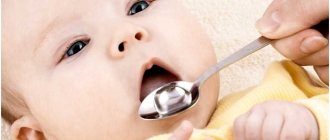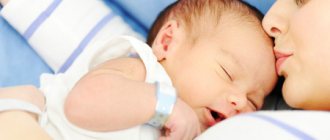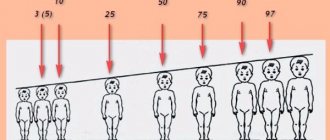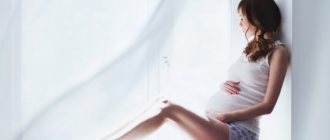The situation when a small child throws back his head and arches his back
As practice shows, in 60-70% of cases, situations in which a child throws his head back and bends do not require medical intervention, since they are completely physiological. But parents, naturally, are concerned about the causes of this symptom. This sign is especially alarming if at this time the baby begins to cry and becomes restless.
Does this happen in healthy babies?
Yes, and very often. It’s just that some mothers closely monitor their children and notice moments when the child arches, while others, who are less attentive, do not. Why can a completely healthy baby perform such an acrobatic trick?
The reasons for this symptom are as follows:
- physiological increased muscle tone of the flexors in children under 6 months of age. It is considered normal, since myelination of the fibers of the pyramidal system lasts up to a year;
- an attempt to learn a new skill in the form of turning over on his tummy. In this case, the baby lies on his side and throws his head back;
- hysterics. If ordinary crying does not arouse the mother’s interest, then the baby, trying to attract her attention, may bend like this;
- bloating and colic. This problem is often observed in newborns up to 3-4 months due to the development of microflora and peristalsis. In this case, arching is accompanied by twisting of the legs and screaming. To prevent such situations from arising, it is necessary during this period of the child’s life to give him Simethicone, which suppresses gas formation, during meals;
- comfortable position for sleeping. While in the womb, children are forced to be in unnatural positions, which they get used to during the last trimester of pregnancy, so they can unconsciously copy them;
- the child wants to look at toys located above his head or the back of his head or neck itches.
If, after trying to eliminate colic or calm the child, he still stands “bridged,” then this is a reason to seek medical help in order to exclude the neurological basis of this symptom.
Pathological mechanisms of behavior
Among the mechanisms of situations in which a child throws his head back, the following can be distinguished:
- the appearance of pathological impulses emanating from foci of damaged neurons. Occurs with cerebral palsy, hypoxic-ischemic encephalopathy of newborns, etc.;
- the action of hyperdischarges generated by areas of epileptogenesis;
- stretching of nerve fibers as a result of irritation of the membranes of the brain with increased intracranial pressure and the influence of toxic substances (meningitis, hydrocephalus).
Manifestations of hypertension
Today, almost all babies are born with increased muscle tone. But by six months this goes away for most. Why? This is explained by the physiological characteristics of the body. But some children suffer from hypertension due to nervous diseases. If the child is healthy, frequent and prolonged head throwing will not occur. He can also sleep on his side, on one side, arched, but gradually this should fade away. There are several signs of increased muscle tone.
- In the tummy position, the baby's head will be thrown back and the shoulders will rise up. Pay attention to where the head is tilted. Since hypertonicity can also be accompanied by torticollis.
- Place your baby on his back. Using your hand, gently lift the back of your head so that your chin points toward your chest. If there is resistance from the baby, there are tones.
Quite possible symptoms include frequent regurgitation, lack of appetite and mood, and tearfulness.
Many parents, having noticed such signs, do not know where to turn. In such cases, you definitely need to visit a neurologist, or maybe a neonotologist. Often these doctors are required to undergo examinations in the first months of life. But if you have gone through them and they haven’t noticed anything, and you think there is cause for concern, go to another specialist. Perhaps there really is no reason to worry. But the parent must be formally sure of this.
Why are tones dangerous and why? Is it possible for them to go away on their own? No. Unfortunately this is not possible. And the sooner the parents come to their senses and take the child to a neurologist, the better. The point is the difficult transmission of nerve impulses to the brain. Children with this problem are often developmentally delayed. They later begin to crawl and sit up, speak and perform other actions.
But in most cases, the problem can be solved within a year. A competent specialist will prescribe not only medications, but also massages. These activities are carried out both in clinics and at home. Only a professional massage therapist knows where and how to press. Do not be alarmed if the baby sleeps for several hours in a row after a session of such a massage. This is considered normal.
Perhaps a course of physiotherapy or paraffin wraps will be prescribed, which children do not really like. But can parents do something on their own in this difficult situation?
Increased intracranial pressure
As a result of the pathological course of pregnancy and childbirth, as well as diseases that occur in the first weeks of a baby’s life, intracranial pressure may increase.
This condition is very serious and requires immediate medical attention, as there is a risk of developing cerebral edema. Symptoms of cerebrospinal fluid hypertension, in addition to throwing back the head and arching, are:
- anxiety, irritability;
- increased reaction to bright light, noise;
- causeless monotonous crying;
- convulsions;
- repeated regurgitation after eating;
- short periods of sleep;
- cyanosis of the nasolabial triangle;
- trembling of the tongue and lips during screaming;
- bulging of a large fontanel and, in advanced cases, divergence of sutures with a change in the shape of the skull;
- excessively rapid increase in head volume relative to other indicators;
- oculomotor disorders in the form of strabismus;
- loss of appetite.
Increased intracranial pressure is often a sign of life-threatening pathologies, for example, meningitis, which in children in 45% of cases occurs atypically.
In newborns
The newborn period (neonatal) is the first 28 days of life after birth. A healthy newborn baby has physiological hypertonicity, which will begin to decrease only by the end of the first month of life. It is characterized by a predominance of tone in the flexor muscles: the arms are brought to the body and bent at the elbows, the legs are bent at the knee joints. In this case, the limbs can be easily straightened. There is also tone in the muscles of the back and neck, so the baby sometimes sleeps with his head thrown back. At this age this is considered normal.
Attention! You can independently determine head tilt as a pathological symptom in a newborn. The technique is simple, but requires the skill of careful handling of the baby. The child needs to be placed in a strictly vertical position, carefully holding him by the torso, shoulders and securing his head. Normally, the head either does not deviate back at all or, after deflection, returns to its original position. Keeping the head tilted back in an upright position is regarded as a positive symptom.
Pathological tilting of the head in newborns occurs:
1. For any damage to the central nervous system during the perinatal period
The perinatal period is the period of time from the 28th week of pregnancy until the end of the first week after birth. Many parents are familiar with the abbreviation “PEP”, which stands for “perinatal encephalopathy”. This diagnosis is made before the end of the neonatal period. After the first month of life and up to a year, doctors observe the baby with “consequences of PEP,” which can manifest as motor, speech or mental disorders. The newly formed brain of the fetus, and then the newborn, is most sensitive to any damaging factors.
Damage to the nervous system, depending on the factor, occurs:
— Hypoxic, caused by oxygen starvation.
Pathology of the placenta, long and difficult labor, and entanglement with the umbilical cord create oxygen deficiency. This is not the entire list. The severity of the deficiency can vary (from mild ischemia to hemorrhages in the brain).
— Traumatic (trauma during childbirth)
It poses a danger especially if the fetus suffered from hypoxia during pregnancy (maternal illness, toxicosis, gestosis, occupational hazards, etc.) and was born premature and immature. Not only the brain can be damaged, but also the cervical spine and peripheral nerves. Birth trauma can occur when labor is conducted too actively using labor stimulation, obstetric aids (squeezing, vacuum, forceps), or breech presentation.
During a caesarean section, the cervical spine is often damaged. During an emergency caesarean section, the risk of birth injury is high if the head is fixed (pressed against the entrance to the pelvis).
Injury to the cervical spine with tension in the neck muscles and fixed torticollis also occurs. The latter can also be congenital, but we will talk about it later.
— Toxic (metabolic)
Alcohol, drugs, nicotine, and some medications taken during pregnancy can adversely affect the development and function of the fetal nervous system. This group also includes incompatibility of the fetus and mother in terms of blood groups and/or Rh factor (hemolytic disease of newborns). At the same time, due to the rapidly degrading red blood cells of the fetus, the level of bilirubin in the blood begins to increase. Having reached a critical level, it penetrates the blood-brain barrier and has a damaging effect on the brain (bilirubin encephalopathy or kernicterus). Typical signs of kernicterus are a forced position of the body with an arched back, rigid neck muscles, and unbending arms and legs.
— Infectious
The development of intrauterine infection before 28 weeks usually causes spontaneous abortion, stillbirth, or developmental abnormalities of the central nervous system. If it arose already in the perinatal period, it is characterized by inflammatory damage to the brain or its membranes (meningitis, encephalitis, meningoencephalitis). Laboratory confirmation of infection is important here. Neurological manifestations vary depending on the location, severity, and type of pathogen.
Whatever the damaging factor or their combination, pathological throwing back of the head (hypertonicity) can be a manifestation of several neurological syndromes:
HYPERTENSION-HYDROCEPHAL SYNDROME
An increase in intracranial pressure (ICP), in which the baby becomes excited, restless, throws his head back strongly, the eyeballs are mobile, and the fontanelles bulge. A spontaneous cry or high-pitched cry (also called “cerebral”) is characteristic. By the way, crying in a healthy newborn is easy to stop. It is enough to feed, give a pacifier, rock or change a diaper. As the syndrome progresses, head circumference accelerates.
EXCITATION SYNDROME
Here, increased physical activity and repeated causeless screaming come first. The child calms down only in sleep and after feeding. When restless, he may arch his back and throw his head back.
CONVIVUS SYNDROME
Generalized tonic convulsions, when the child arches his back and throws his head back, indicate severe damage to the nervous system. Local tonic-clonic convulsions are more common - twitching of facial muscles, limbs, grimaces, tonic abduction of the arm with turning the head, etc.
Depending on the severity of the lesion, pathological hypertonicity may completely disappear or progress. In the latter case, they speak of MOVEMENT DISORDER SYNDROME as an early harbinger of cerebral palsy.
2. For congenital torticollis
We have already mentioned torticollis as a result of birth trauma. There is also a congenital form, which can be unilateral or bilateral, early (noticeable immediately after birth) or late (diagnosed after the 2nd week of life). With a one-sided form, the head is tilted towards the shoulder, and the chin is turned in the opposite direction. Trying to change the position of the head will cause pain in the baby. The reason is the underdevelopment of the sternocleidomastoid muscle. If the torticollis is bilateral, then the head is completely thrown back.
3. Lactase deficiency, dysbiosis
In newborns who have suffered hypoxia, intestinal function may be impaired. Relative or absolute lactase deficiency provokes intestinal colic and stool upset. The enzyme lactase breaks down the disaccharide lactose found in breast milk. If its function is impaired (or the enzyme is completely absent - in the congenital form of the disease), then excess lactose provokes the growth of fermentative microflora, dysbacteriosis, bloating, and abdominal pain. The baby reacts to any pain with excitement. He will cry, wiggle his legs, throw back his head. This is not classic colic, which usually occurs in children after 1 month. However, the clinical manifestations are similar in both cases. A stool test for lactase deficiency will help you figure it out.
We recommend reading: Why doesn't my child sleep under the covers?
Child “on the bridge” with muscle hypertonicity
Muscle hypertonicity is most often observed against the background of fetal hypoxia in the prenatal period or during prolonged difficult labor. The result of this is encephalopathy and cerebral palsy. Excessive muscle tension can be one-sided or affect both sides of the body. Until the age of six months, even doctors sometimes find it difficult to determine the mild degree of the disease.
Parents usually pay attention not only to the fact that the baby arches his back and throws his head back, but also to the constant flexion (bending) of the limbs, as well as movement disorders in one of them. For example, a child uses only his right or left hand to grab a toy.
Whims or hypertonicity - how to determine
To understand why a baby throws his head back during sleep, you need to pay attention to the accompanying symptoms.
Hypertonicity is manifested by frequent regurgitation and decreased appetite. The baby often cries, worries, gets irritated, and rarely smiles. Healthy children sleep not only on their backs: the baby can fall asleep on his side or on his tummy; tilting back is infrequent and does not last too long. Possible blueness of the nasolabial triangle when tilted back, trembling in the chin.
Other states
Among other reasons for a child to throw back his head are torticollis. At the same time, the upper part of the baby’s body seems to be fixed in a certain direction, and an attempt to change the position when he is lying causes anxiety and crying. This condition requires medical intervention with a course of massage and physiotherapy. In severe cases, it is necessary to prescribe muscle relaxants, wear a special collar, and sometimes surgery.
Also, the cause of the “bridge” is often epilepsy with tonic seizures. The baby freezes for a short time, does not react to anything, and after the attack, defecation and urination occur.
Prevention of infant head tilt and hypertonicity
Child health prevention
Not everything can be done by loving parents for their baby; they must strictly follow the pediatrician’s instructions so as not to harm the baby. But certain preventive measures can and should be carried out by ourselves:
- It is sacred to believe in the recovery of your child, to do everything possible for this.
- If the baby does not suffer from allergic diseases, give him soothing baths from infusions of chamomile and pine needles.
- Attend swimming lessons with your child in specialized pools under the guidance of an instructor. For the child, you need to purchase an inflatable ring that will support the baby. Swimming is one of the best ways to relieve tone, since warm water tends to calm the nervous system and has a good effect on the development of motor skills.
- A useful exercise for reducing tone is to position the child's body upside down. The form of play suits him well. The baby's legs should be placed on your forearms, while the baby's head and neck remain in your arms at this time. You need to lower the child upside down and hold it like that for a while.
- You can perform a relaxing massage that does not require special skills. Stroke the baby's body and massage his fingers: a mother's touch calms the baby.
- Sometimes lack of attention to the child from the parents is the cause of hysteria. The cause needs to be eliminated, and throwing the head back while crying can stop, since this is one of the ways to attract the attention of adults to a wet diaper, excessively loud and tiring sounds and other troubles.
- Redistribute the objects surrounding the crib evenly so that they are on both sides of the crib rather than on one side. You should not allow a situation where the baby throws back his head or turns it to one side in order to look at a curious object when he falls asleep.
- There is no need to panic right away. Try to believe that the child is doing well.
- Watch the baby. If you find that the head continues to tip back with additional symptoms, immediately seek help from a neurologist.
If you have any doubts about the diagnosis, examination results, or course of treatment, seek help from another doctor, the head of the department or the hospital. You will be understood correctly, because your concern concerns the baby’s health. Do an examination, consult with specialists in the interests of his health.
Which specialist will help you sort out the situation?
Some parents, noticing such arching in a child, do not always know what to do about it and which specialist to contact. First of all, you should calm down and watch the baby. Any doctor will begin to ask leading questions, without answers to which it will be difficult for him to fully imagine the clinical picture.
You must clearly know the following:
- At what point did the head tilt appear and how long does it last: from birth, a week, a month, etc.?
- Was this event preceded by a fright, a fall, or an infectious disease?
- when does the child arch: in sleep or during wakefulness and what is this accompanied by: screaming, cyanosis of the nasolabial triangle?
- Does the baby react to external stimuli at this time?
Only after a detailed history and examination will the doctor be able to determine the minimum list of diagnostic measures.
If a newborn has a “bridge” symptom, then first of all you need to visit the local pediatrician who patronizes the baby. He will be able to suspect a pathology of the nervous system if it is present and will refer you to a pediatric neurologist for further examination.
Causes
There are 2 types of reasons why a child may sleep with his head thrown back. Quite harmless and those that require a special approach and serious treatment. Why does the baby do this?
- Physiological features. Sleeping while lying back is normal for up to 4 months. Unless the throwing is accompanied by other symptoms.
- Neurology. This includes intracranial pressure and hypertonicity.
- Birth injuries.
Children born by caesarean section, using special forceps, and born with breech presentation deserve special attention.
If you notice such features in your baby, first observe when this happens and how, where he tilts his head. The doctor will need this information to make an accurate diagnosis. What exactly should you pay attention to?
- What time of day is the baby sleeping or not?
- Where the head is turned in this case, perhaps the rotation occurs mainly in one direction: left or right.
- If tilting occurs only in sleep, on which side does the child prefer to sleep at this time?
- How often does this happen?
- Is the child able to focus his gaze on one object?
- Do seizures occur?
Only a qualified specialist can determine the cause. But everyone needs to know the signs.
What diagnostic procedures are needed for a baby if he arches his back and throws his head back?
To understand whether the throwing back of the head and arching of the back in a baby is a physiological condition or a pathology, the doctor first needs to collect complaints (these are presented by parents), a life history (pregnancy, childbirth, early neonatal period) and diseases, and conduct a detailed physical examination. If during this process signs of damage to the nervous system are detected, the following examination methods are usually recommended:
- laboratory tests (clinical analysis of blood, urine);
- neurosonography - ultrasound diagnostics, which is performed on children under one year old, since their large fontanel is still open;
- electroencephalography - to exclude epilepsy;
- CT and MRI are used extremely rarely, despite their information content. These technologies require the use of anesthesia to immobilize a small patient.
You cannot refuse the proposed diagnostic measures, because in this case you can miss a serious disease of the nervous system.
When is it necessary to consult a neurologist?
A doctor's help will be required if the birth was difficult, since there is a high probability of injury, which may cause abnormalities to develop. The sooner the child is shown to the doctor, the sooner the diagnosis will be made and treatment prescribed; there will be fewer consequences, complications will not be as dangerous as if there is a delay. It is especially important to show the child to the doctor in a timely manner if, after childbirth, hematomas remain on the head, or if developmental disorders of the central nervous system organs are diagnosed.
It is necessary to show the baby to a specialist if there are signs of hypertonicity. If the child arches while lying on his side, there is decreased interest in food, low activity and frequent regurgitation, one limb moves worse than the other, it is also important to start treatment on time. In addition, a situation when a baby shakes its head from side to side in its sleep, or when the position of the head changes, a crying baby’s arms and legs begin to shake, is considered an alarming symptom.
You can consult a doctor for prevention if parents are not sure about the nature of the observed phenomenon. The doctor will tell you whether there is a pathology. If the doctor does not find any dangerous abnormalities, but the parents are still worried, you can visit another specialist and get a second opinion. This will help avoid medical errors and incompetence.
Source
How to help your baby?
If, based on the results of the examination, it turns out that the child is absolutely healthy and the reasons for arching are physiological, parents need to: reconsider the environment in which the baby is located, treat him more attentively, preventing the development of hysterics.
Regular massage in the form of stroking and gymnastics performed by mom or dad has a good effect on the condition of newborns. Bath procedures also calm the baby: these can be baths with lemon balm or even swimming with a special circle.
Try to arrange the toys in such a way that the baby does not have to throw back his head and take unnatural poses. There should be a special orthopedic pillow in the child’s crib; the mobile should be hung not at the head, but in the center.
What should parents do?
First of all, stop panicking. The well-known doctor Komarovsky believes that arching of the back and throwing back of the head in infants is a fairly common symptom. Such behavior may not always indicate neurological problems. All newborns have muscle tone, and it can be expressed in this way. Therefore, before you run to the doctor, observe your child’s behavior. The doctor will definitely ask related questions, and the diagnosis will be more accurate if you can answer them.
- When was the problem noticed? From birth or did it appear after a few months? Was this the result of some event, such as a fall, fright, etc.?
- When does this happen - during sleep, wakefulness, crying, playing?
- Is the pose accompanied by other symptoms, such as muscle tension, quivering lips?
- What is the child's gaze at this moment?
In your baby's play area, distribute toys on all sides so that he can move his head freely. Constantly change the places of stimuli to prevent throwing your head towards the objects of interest.
Give the baby a relaxing massage yourself, include gymnastics. Your pediatrician or massage therapist will tell you what exercises to do. Usually these are light stroking and bending of arms and legs. Such procedures relieve tone, and tactile contact with the mother has a calming effect.
Water procedures. Even if you can’t go to the pool, you can swim in the bathroom using a special circle. This is good hardening, prevention of tone and development of motor skills.
Try to prevent tantrums, do not leave your newborn in a dirty diaper, pay more attention to him, do not allow him to go hungry or overeat.
Perhaps tilting your head is just a way to get your attention
Reason to see a doctor promptly:
- the baby eats and sleeps poorly;
- burps frequently and a lot;
- the baby is lethargic and shows no interest in external stimuli;
- tremors of the limbs or chin while crying;
- blue discoloration of the nasolabial triangle;
- the child cannot concentrate his gaze on an object or the faces of his parents;
- obvious hypertonicity;
- one arm or leg is more active than the other.











